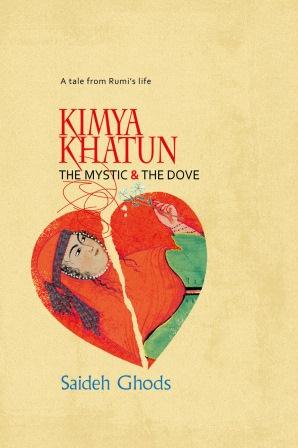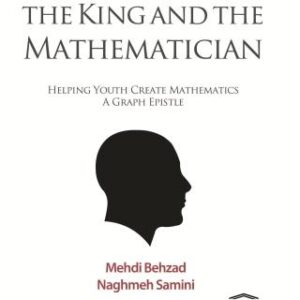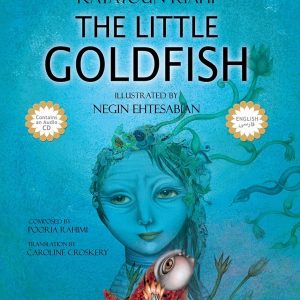Thirteenth century Konya is home to Muhammad Jalal ed’Din Rumi, the world renowned Persian poet, jurist, theologian and Sufi mystic and his stepdaughter, Kimya. Rumi was and is revered by his disciples even to this day, but where and how did his journey from His Holiness the beloved cleric to Rumi the ground-breaking mystic begin?
Saeedeh Qods, author and philanthropist, says that she grew up listening to her mother recite Rumi’s poetry at bedtime. Later, she went on to carry out extensive research about Rumi in Iran and the neighbouring countries to satisfy her curiosity about the man. Her investigation reveals the unbelievable tale of how Rumi lived and what life was like for those closest to him; we are treated to a vivid account of a man whose words mystified and mesmerised believers the world over. This novel helps us to understand how reputations can be built.
Rumi was born and lived his early life in a village in the province of Balkh, now Tajikistan, which came under the cultural sphere of Iran and was an area once governed by the Eastern Roman Empire. Rumi’s father, Baha ud’Din Walad, decided to take his family west to avoid the impending Mongol invasion and they eventually settled in the Anatolian city Konya, in present-day Turkey. This is where Rumi was to have a profound influence on the culture of the region; he composed one of the most important oeuvres in Persian literature in Konya and it is where the story begins.
Qods opens a porthole on life in the harem of His Holiness, a place that is quite unexpected. Unlike a typical harem, His Holiness kept only one wife but she is surrounded by a host of female relatives, of all ages, whose well-being he is responsible for. Kimya’s vividly woven tale enables us to become familiar with the interactions between the women that live in the harem, from the perspective of a bewildered adolescent. The harem was like a mini-citadel which was home to women of many ages, whose well-being required their interdependence and whose mood was often dictated by the demeanour of His Holiness. This insular world brought a great deal of melancholy to His Holiness although it is unclear whether it was the tradition of the harem that brought this about or whether it was connected to the obligations he felt towards the wider community of the city itself.
This is a manifold tale oflove and adolescence which embraces the age of innocence and shows us the ultimate personal sacrifice. The author immerses herself in the character of her heroine, Kimya and begins to experience all that she felt growing up in the harem of one of the most notable men of the time in that region. We are introduced to all her thoughts as she succumbs to the restrictions in a house where trips to the hammam become the highlight of her life; a life where occasional, covert trips to the rooftop fan excitement because they are the only times when she can glimpse the world outside her home full of women.
For Rumi, religion was mostly a personal experience, but the members of his harem as well as his family and school of clerics could not escape the beliefs of the time which dictated a certain way of life for religious, scholarly men and the women who inhabited their harems. At the time, Rumi’s new school of thought brought a great deal of tumult to both his harem, his family and his school and saw him discredited by the wider community in the early days of his enlightenment. As the author also delves into the character of Rumi’s sons we can begin to appreciate the extent of the man’s change on those around him; his eldest son, Baha’eddin, went on to becomeSultan Walad and found the Mawlawīyah Sufi Order, also known as the Order of the Whirling Dervishes. Conversely his step-daughter, Kimya, suffered the cruelties of his mentor.
The author insists that her work is not about promoting the case for women but is more a thorough search through the life of a man and how his choices impacted on the members of his family. Whilst Rumi’s eldest son joins him in finding enlightenment and fulfilment, Kimya is betrothed to Shams, a man much older than the beautiful maiden, who is brutal to our young heroine and her anguish brings a great deal of unhappiness to the entire harem.
The tale allows the reader and those who enjoy Rumi’s poetry, to develop a deeper understanding of what enabled him able to articulate the highly personal and often confusing world of personal growth and development in a very clear and direct fashion. He does not offend anyone; he includes everyone. Rumi’s visions, words and life teach us how to reach inner peace and happiness so that we can finally stop the continual stream of hostility and hatred and achieve true global peace and harmony.
‘Kimya Khatun’ the original version in Persian, was published in 2004 and in less than four years reached its fourteenth reprint. It has so far sold in excess of 80,000 copies in Iran.
Saeedeh Qods divides her time between US and Iran and is substantially involved in Mahak, a charitable organisation helping cancer-afflicted children in Iran.





